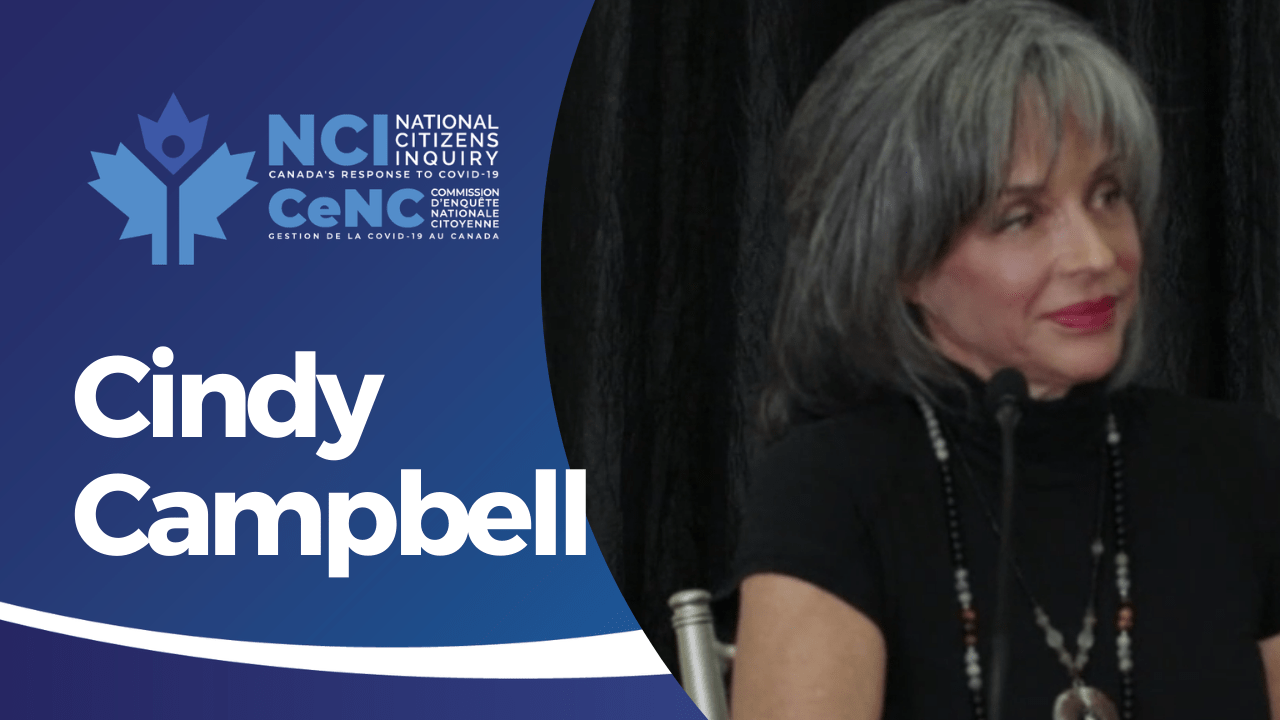Cindy Campbell is a Registered Nurse. During her testimony she explains how early pandemic policies were tied to sustaining hospital function. Now, ER departments are closing due to nursing and staff shortages. Quality of care is at risk for the patients and community. She explains how these policies are threatening healthcare.
View / Listen: Rumble|Apple Podcasts|Spotify|Google Podcasts|Podbean
[00:00:00]
Geneviѐve Eliany
Could you state and spell your name for the record please. Or should we wait for the fourth commissioner to return? No? Okay, very well. If you could state and spell your name, please.
Cindy Campbell
My name is Cindy Campbell and that is C-I-N-D-Y C-A-M-P-B-E-L-L.
Geneviѐve Eliany
Since you’re in person, you may notice that I’m not always looking at you and it’s because of the Zoom screen of course, so I hope it won’t be too distracting for you.
Cindy Campbell
Don’t worry.
Geneviѐve Eliany
I understand you were a nurse for a very long time, for 30 years, is that right?
Cindy Campbell
Correct. Twenty-eight years to be exact.
Geneviѐve Eliany
And you have an unusual balance of frontline skills and academia. Is that fair?
Cindy Campbell
Correct.
Geneviѐve Eliany
Okay. Why don’t you tell us about some of your work in academia?
Cindy Campbell
Sure. So just to detail a bit about my education, I started as a Diploma Nurse from Mohawk College in Hamilton and then got my Bachelor of Science in Nursing from the University of Victoria. Then I went on to complete a Masters in Science in Health and Aging at Queen’s University. I went on as well to do some—two actually—very competitive RNAO [Registered Nurses’ Association of Ontario] Advanced Clinical Practice Fellowships. And on my first one, I published a paper: “Training of Endoscopy Nurses.” And then in terms of my academic components at work, I did go on to be an educator; but prior to that I always very much prioritized my frontline contributions. I found that that was essential and often a lot of a disconnect with, let’s call them the “higher-ups, is that they didn’t really have that frontline long-term experience. That’s sort of the engine of the hospital that I always probably found the most rewarding of my work.
Geneviѐve Eliany
By frontline you’re referring to hospital work, that would be about the ER and in the operating rooms?
Cindy Campbell
Correct. Now, I was in perioperative services. I’m a certified operating room nurse and I also held certification from the Canadian Nurses Association in gastroenterology. And I was able to work across— I was the only nurse in my hospital actually that could work across all divisions of perioperative services, so I could work in the OR, our recovery room area, and also in our endoscopy unit.
Geneviѐve Eliany
Going back to your fellowships: You mentioned them very humbly, but these fellowships were through the Registered Nursing Union of Ontario?
Cindy Campbell
The Registered Nurses’ Association of Ontario. The RNAO. Yes.
Geneviѐve Eliany
Thank you for that correction. And my understanding is that it’s quite rare, or it’s a privilege, to do these fellowships?
Cindy Campbell
They really are. They tend to be very, as we said, very competitive. And you really have to have a really well laid-out application package. And also, you really have to have the support of your hospital behind you, so the hospital has to really endorse what you’re doing. And you also have to be a respected employee to have established that rapport and trust to go ahead and be granted one of those. So it’s a combination of the application and the hospital end.
Geneviѐve Eliany
One of the fellowships was with respect to the knowledge or the practice gap for new graduates. Is that correct?
Cindy Campbell
Correct.
Geneviѐve Eliany
Okay.
Cindy Campbell
My hospital was concerned. There’s sort of a quite established body of evidence in the nursing profession of sort of a well-identified practice gap with recent grads. And this is that they are lacking—through no fault of their own—but they’re lacking in a lot of the clinical skills and some of the coping mechanisms and that kind of thing, to endure when they get thrown into, so to speak, a full-time job. So this particular fellowship was to try to interview different levels—whether that be university profs, nurse educators, frontline nurses—and to try to devise ways that perhaps as the hospital we could move forward to better support our new grads transitioning to practice.
Geneviѐve Eliany
So that will eventually take us to some of our later discussion on the effects of the pandemic.
[00:05:00]
Let’s set the stage with respect to the hospitals early on in the pandemic. What was happening both in the ER and in the operating rooms? How busy was the hospital?
Cindy Campbell
Now again, I can only speak to what I would have witnessed as an OR nurse at that time. I was actually casual at that period. It was just before I was doing some of the fellowships. I was casual in my ambulatory surgical unit. That unit was closed and we were told we were going to all be put into the main OR. And from my perspective of what I saw there— Now to be fair, I didn’t come in that often during the pandemic, proper, at the beginning. That was because at the beginning I was told I would be needed to cover a lot of sick time and that I would be trained with all the other nurses to be redeployed potentially in need units across the hospital. But that never happened. I rarely came in to cover sick time. And in terms of going to the other units, I also was never redeployed there. And the majority of the staff I worked with, from what I’m understanding, were not either.
What I think people didn’t understand about the pandemic is: let’s say you were to take an area like the operating room. We had, let’s call it, 16 rooms. When you start closing those rooms down to, say, emergency rooms only, which is what they did— So let’s say that was, I forget—let’s call it five ORs functioned out of 16—you now have a surplus of staff. Because again, you can’t just tell people not to come in when they have been booked or guaranteed work—part-time or full-time staff. So that had excess staff in the OR alone. And then the recovery room is also staffed to accommodate that number of patients, which was dramatically reduced. And then so on throughout the hospital. There’s ambulatory clinics that were staffed with nurses that were also closed down.
So in actuality, from what I was seeing, there was a lot of excess nurses that were often being used to do quite menial jobs. Not menial, important—but jobs that wouldn’t necessarily have conveyed what the nurses at that time were being depicted as being, quite stressed out and overworked. A lot of them were doing testing, surveillance of people coming into the hospital, that kind of thing. And I did note that the staff rooms were amply full of staff. And just, like when you see those videos of the staff dancing and doing the conga lines and the pillows in their pants and stuff and goofing around, that would have been a fantasy for me in my work, to be able to have that much time. Never in my history of work would we have been able to have danced around. Never.
That’s not to say that a lot of nurses did not work very hard, but certainly I suggest that not all the nurses deserved the accolades of the heroes that they were getting at that time.
Geneviѐve Eliany
On the few times you were called in to work, how busy were the emergency rooms as far as you could observe? I know it wasn’t your ward, but I understand you had to walk through there.
Cindy Campbell
Yeah, so what I observed of the ER— And again, to be fair I was not in there with any significant regularity, but all I can do is compare it to what I was used to. My unit used to be attached to the ER, so I would often go in there for supplies or to send samples, specimens, that kind of thing. And the ER prior to the pandemic resembled what I would call a war zone. It was beds in the hallways, every cubicle full, the nurses super busy. And in the times during the pandemic it was, compared to that picture, very calm: beds not full, cubicles not full, nurses sitting more and having a bit more time by all appearances. And again, nowhere nearly the pictures that I was expecting or what I was used to.
Geneviѐve Eliany
Now, of course, that changed as the pandemic advanced.
[00:10:00]
What happened with respect to staffing levels once the vaccinations became required?
Cindy Campbell
Well, again, that’s kind of difficult to say, only because of what was happening during that time. Don’t forget, unvaccinated and vaccinated nurses were working shoulder to shoulder and there was no issue. And they were hailed, as we said, as equal heroes—the vaccinated and unvaccinated were both hailed as heroes.
In terms of what happened to the staffing, those numbers really were not declared. The hospital did not announce their official numbers. And again, I think what a lot of people aren’t understanding when they’re told about losses in health care is they’re not given an accurate picture. We hear people like Doris Grinspun from the RNAO disqualifying and just dismissing this as a small, few number. Meanwhile, what they’re not telling people is that the hospital at that time said to nurses and everyone, “Hey, if you want to leave right now, leave. And we won’t put a black mark on your record and we won’t report you to the College.” Because it is process that every time a nurse is terminated, that report would go to the CNO [College of Nurses of Ontario]. And of course, justifiably, that worries and concerns a lot of nurses. So a lot of nurses resigned and possibly even—I can’t say it was equal number or even more, I don’t know—but let’s just say that anyone younger-looking, to keep working in the profession for numerous reasons, would have much more taken the opportunity to have accepted the resignation route versus the termination route.
And there was another field, of course, of people who took early retirement that I’ve heard of. They did that way out as well. They’d had enough. And another group took leaves. And that’s another segment that is also typically not captured in apparently these tiny numbers discussed in the press.
Geneviѐve Eliany
My understanding is that apparently at Hamilton Health Sciences—and that’s a very large health network—the retirement rate was 30 per cent.
Cindy Campbell
Well, apparently, over 2022, it had a 30 per cent increase. And Hamilton Health Sciences is an interesting one, just to sort of give an example of potentially some numbers that were lost here. I’m not saying they were all lost to mandates but in September of 2021, Hamilton Health Services listed about 700 vacancies. Then that is when they started threatening the policy. They brought it in officially in January. And a recent report coming out of that same health network reports staff vacancy now of 1,500 staff—so that about doubled their vacancy rates since then plus potentially, they had the retirement rate go up as well.
Geneviѐve Eliany
We’ll take a step back to some of the medical recommendations from Dr. Kieran Moore and what the hospitals did. Can you tell us what the official guideline from the Chief Medical Officer in Ontario was with respect to vaccine mandates for staff and what the hospitals ended up doing?
Cindy Campbell
Yeah. And that’s kind of the puzzling part here. Our Chief Officer of Health, in a Directive 6 that he put out in August of 2021, had an accommodation for unvaccinated workers to keep patients safe and protected. And that was to do regular antigen testing.
And it was potentially at that time, to sort of give a bit of a timeframe: in July of 2021 you have the CDC [Centres for Disease Control and Prevention] acknowledging that there has been sufficient data to show that there has been vaccine breakthrough reinfection and that evidently the vaccinated, once sick, were carrying the same viral load as the unvaccinated. And that is why you saw the CDC’s mask recommendations change.
[00:15:00]
For a little while it was, “Hey, the vaccinated don’t have to mask,” to suddenly, “They do have to mask.” So they knew something, as did Kieran Moore, as did the hospitals: that this vaccine was starting to show some inabilities or limitations to quite live up to the standards of a newly vaccinated individual. So as we said, the hospitals went ahead. And instead of listening to Moore’s accommodation, they followed the Ontario Science Table. And the Ontario Science Table allotted for no accommodations. It was either vaccinate or nothing. They took much more the militant stance versus the offering workers a choice.
Geneviѐve Eliany
Before we move on to the choice issue, while these policies and mandates were in place for staff, my understanding is that unvaccinated visitors were allowed into the hospital. Is that right?
Cindy Campbell
There was a time when, sadly, they were not, but the policies did change. And over the last, thankfully, several months, even longer, they did stop them. And there are certain hospitals like St. Joseph’s Hospital in Hamilton, where I believe that the unvaccinated visitors were allowed—in the process when they were firing people as well. So that was definitely an inconsistent application of the policy.
Geneviѐve Eliany
Yes, apparently, visitors somehow become more important than nurses, which is peculiar.
Cindy Campbell
Correct.
Geneviѐve Eliany
So going back to the choice. Often, people will say that immunizations, vaccinations are nothing new for staff in healthcare. Can you comment on how it’s true that there are policies and requirements, but on choices that exist for all the other vaccinations?
Cindy Campbell
Yeah. So again, that’s another bit of a massaged fact. There are in fact required vaccines to obtain jobs at hospitals. But when I hear Anthony Dale, CEO of the OHA [Ontario Hospital Association] speak, he mentions things like TB, hepatitis, and measles/mumps/rubella [MMR]. To clarify some of those: TB is not a vaccine requirement, that is done by a skin test that is taken. Hepatitis: the majority of hospitals that I know of, it’s a recommendation, not a requirement. And indeed, things like MMR and chickenpox often are requirements. However, they allot for natural immunity, so they allow staff to show proof of antibodies, proof of past infection. And that is not the case in COVID of course, even though now they have good evidence to show that natural immunity is indeed as strong as, if not possibly stronger than, two vaccines. But natural immunity is completely disqualified in this case.
Also in hospitals, they used to—when I say used to, they still claim to but their past behavior shows they are not—give religious or creed exemptions. An interesting case in my hospital is that I had a colleague start working in the OR, I believe it was about six or eight months prior to the pandemic. She submitted a religious exemption for MMR vaccine and the hospital accepted it and had her working in the hospital. That same nurse was fired for the same religious exemption just that short window later. And hospitals also used to accommodate medical exemptions without a near threat of death, which now appears to be the standard for COVID. And time and time again, there’s nurses who had to leave nursing because they’ve had quality medical concerns, that their doctors confirmed were indeed warranted an exemption. But every doctor said, “I cannot write this for you, I will lose my license.” And that is unprecedented.
So again, it’s this lack of choice that is concerning in a democracy and in Canada.
[00:20:00]
We have an interesting arbitration finding out of British Columbia. That was, the Health Services Union there put forward a— They challenged a mandatory mask or vaccinate policy. And this was where they offered the choice of, “You can take a vaccine or you can wear a mask—an influenza vaccine or a mask.” That policy was won by the employer but the arbitrator had some pretty clear words about choice. Throughout his findings, it is consistent that he emphasizes the dignity of choice over receiving a medical procedure. He confirms that if the mask was being used for the sole purpose of increasing vaccination rates, he would be very concerned. And that would not be something that would be within the letter of the law. Again, he consistently speaks about policy that had to be not arbitrary but logical, reasonable, fair, and equitable of course. And interestingly enough, one of the expert witnesses for the hospital, Dr. Van Byunder, I believe his name is, said: “You know, we really want to give our people a choice. We have many valuable people with religious concerns that may not want this vaccine and we want to give them the choice of a mask.”
In this case, with COVID vaccines, we had the choice of taking testing. And again, that would have been the humane, dignified way to do things, but that was rejected. And again, the Ontario Science Table put forth some very puzzling data. For example, in the height of being just about to begin their terminations at hospitals, they put out a report about the risk of burnout to the healthcare workforce, and how that burnout was getting to be to unsustainable levels, and that likely it would cause again an unsustainable hospital workforce. They also said that hospitals must take every measure they can to secure staff, to reduce turnover, and to reduce overtime, that kind of thing. So from this corner of their mouth, they’re saying, “Stop burnout. It’s dangerous. It’s going to cause our system to collapse.” And this corner of their mouth, they’re telling the hospitals to terminate nurses.
If I could go on, I found it very again, shocking from the Ontario Science Table. Here, if you can read their letter to Ford in support of mandatory policy, it is a very—wow—shocking read. I wonder if all the people standing behind the Science Table actually even read this document. It begins by saying, “We know staff turnover is a problem and we don’t want it, but we know that vaccinated [sic] staff are going to get really sick all the time and they’re going to cause a lot of burn-out to the vaccinated that, of course, are never going to get sick and are going to stay there working. So you’re better to fire them than let them have sick time.” And that’s very rich, because data from FOIs [Freedom of Information requests] submitted to these hospitals showed that staff illness rates in hospitals with mandatory policies in place went through the roof in January with Omicron. Also B.C. shows: at one point they were talking again about record-breaking staff illness; 28,000 staff was off in one week in B.C., a province with a mandatory policy. So this showed not only some of the limitations of the vaccine to control Omicron, but that the policies in fact had some pretty questionable outcomes, potentially.
Geneviѐve Eliany
It was so bad in B.C. based on what I’ve read—and I believe also in a few small towns in Ontario—that hospitals closed in rural areas.
Cindy Campbell
Yeah, that’s very concerning.
[00:25:00]
And again, all of this speaks to the necessity of these hospitals to have done risk assessments, to have figured, “Okay, how is what we do to our staff going to impact public safety?” And we all know now that apparently our livelihoods, our children’s education, and everything appears to now be tied to hospitals—sustaining hospitals, hospital resources. So to have hospitals fire trained, experienced staff and potentially lead to some pretty serious concerns that happened as a result: I mean, we have a Toronto Star article that speaks about an analysis that showed a staggering number of closures across the province. The nursing shortage by ER doctors was described as brutal. Some said that the healthcare networks were on the verge of collapse. And like we saw with that data from Hamilton Health Sciences, the vacancy rates went through the roof.
The more concerning part is that these hospitals—and maybe not even call them hospitals anymore, I think what we have to start doing is making the CEOs that did this accountable. These CEOs knew well that there were already significant vacancy rates at their hospitals when they put in these policies. And that subjects their patients potentially to some pretty serious quality and safe care concerns. And these CEOs also— Their responsibilities now, like we said before, with the functioning of healthcare to their community, they need to start realizing that their obligations extend beyond just their walls. They can no longer when they make decisions like that, just say, “Well, this just affects our patients and our staff.” Now we know that we’re intimately tied to hospitals and keeping hospitals going. As we said, I think that if they had been following proper, well-established standards around developing policy, that starts always with a risk analysis. And I would argue that these institutions likely did not do that. And that put the public at risk. It put their patients at risk.
And the risks from these kinds of policies are numerous. Another major risk that is never discussed is the risk of demoralization of staff that felt as if they were coerced to vaccinate. And what do you do to staff, or how does staff react, when they come back into a workplace setting where now they feel depersonalized, they feel detached from their employer, they’ve lost their support. You now have potentially higher absenteeism rates, staff that just are not invested any longer. Again, burnout and leaving the profession if they felt violated like that. I read a report out of New York state when they put in their mandate and it bragged that they had 55,000 workers fold in the last week. That’s nothing to be proud of. That is shocking to do that when they had a choice. And no one is not honoring a nurse’s responsibility to protect patients. Of course they have to and they have to play a role in that. But there are many non-pharmaceutical, reliable, safe, consistent ways that healthcare professionals can protect and it does not have to be a vaccine. And that was acknowledged by our Chief [Medical] Officer of Health.
The other major risk is financial risk. And that one should have stopped this immediately on that alone. You know, when you do a financial risk analysis, your first option is to look at the least costly ways to meet your objective. And the least costly way clearly would have been again to have offered antigen testing. What they’re facing now is costs of retraining. And I was reading some material from human resource expert and to replace a mid-level employee, you’re talking about potentially around 150 per cent of their yearly salary to do that.
[00:30:00]
When you start getting into specialized knowledge, you’re now looking at even upwards of sometimes 400 per cent of their yearly salary. And when you look at some of these nursing jobs or some of these, again, other skilled workers at our hospital: this is extremely specialized knowledge that they had. They fired ICU nurses with 30 years experience. They fired NICU nurses with tremendous experience. And that is criminal: what they have potentially done to patients that could have benefited from those nurses’ care. Also, replacement costs: they have reports that they were hiring agency nurses at incredibly inflated rates, paying double time, time-and-a-half. And then they’ve got union arbitrations to manage. So to a universal healthcare system that was already in crisis long before the pandemic, this alone is a very reckless act on behalf of the CEOs—doing this without properly looking before they leapt.
And that’s what I would argue that they did. They did not, in my opinion, look at the proper thresholds—particularly with a vaccine that has, what is now being revealed to be rather significant limitations, and the evolving nature of this pandemic.
Geneviѐve Eliany
For the staff members who were reluctant to accept a vaccine because they don’t like the mRNA platform, were they offered what I’ll describe as an old-school vaccination based on an inactivated virus? We know that both China and India have those vaccines. Was that ever an option?
Cindy Campbell
At our time, when our nurses were fired, that was not an option. To my understanding, it was just the mRNA at that time. There has been since a Novavax vaccine that has come out. I’m not sure quite of its platform that it uses. But at that time, we only had those options.
Geneviѐve Eliany
Thank you. The Novavax, I believe, is just a lab-made spike. It’s not the full inactivated virus, but we won’t get into that.
Cindy Campbell
Okay.
Geneviѐve Eliany
Now, let’s get back to the realities of the staff shortages. What’s the approximate average age range of the members that you’ve lost? You’ve commented on experience but what age range would you say?
Cindy Campbell
Well, you know that’s kind of a significant thing that just I’ve sort of—I’ve just been talking to a lot of people and trying to get lots of qualitative, good, rich data from some of these people who have been fired. And it tends to be that a lot of them were in kind of that sweet spot where the public could have probably got at least five, ten years out of some of these very experienced nurses, who just thought, “No, we’re not doing this anymore.” Our data shows us clearly that before the pandemic, we had an aging workforce. And already at that time it was a significant amount of the staff. They already knew these nurses were 50 and over and that we’d be facing a nursing crisis once we start losing these members. So to hold on to those old nurses, for lack of a better word, was imperative. But rather than hold on to them this would have pushed them aside. And lost them.
Geneviѐve Eliany
Can you give us a sense of the geographical origin, where the nurses came from, in cases of sort of more vocal nurses who resisted the mandates?
Cindy Campbell
When you say, “where they came from,” do you mean the hospitals or the—?
Geneviѐve Eliany
I didn’t word that very well. I apologize. So which countries did these nurses come from? The ones who protested the most?
Cindy Campbell
Well, again, hard to say. Generally, the U.K. seemed to have had quite a good pushback. The U.K. dropped their policy. And actually, it was interesting because the House of Lords in the U.K., they had a ruling that they rejected mandatory policy.
[00:35:00]
And the reasons were that “the potential benefits of the proposal were disproportionately small given the subsequent costs for recruitment and the disruption it would have to the health service.” And they stated they would have to be provided with very strong evidence to support this policy.
So again, in terms of nurses that were fighting back, I think it was consistent across many countries, so hard to say just one, but—
Geneviѐve Eliany
What about immigrant nurses here in Canada? Like the Chinese nurses? Like the ones from Eastern Europe?
Cindy Campbell
That’s a really good point. Because I think what I took issue with a lot with this was, as a nurse, I look at populations. And we’re all taught this: to always look at the lived experience of people and where they come from. And perhaps instead of the name-calling and hate-mongering, I’m just going to call it, that has been going on when someone declines a vaccine, to look at some of where they came from. And so you have to look at their backgrounds. Now, we know Canada is a country of immigrants. We welcome people who escape communism, authoritarianism, dictatorships, and they came to Canada for freedom. Instead, they got told that they would have to take a vaccine against their will. And these kinds of populations, they stood up in my hospital. I had a nurse who had arrived from China just several years earlier and she just said, “You know, Cindy, this is not what I came to Canada for. I came here for freedom and now this is happening.”
I have a very sad story of a Serbian family from Hamilton. Both of them went through the Serbian War, they came to work in Hamilton Health Sciences, and both of them lost their jobs. And they were literally in PTSD from this. And people can mock as they will on the other side but these are really painful experiences as to why people decline vaccination. And you know, we also have demographics that have generational trauma—well-earned mistrust of the pharmaceutical industry and of health authorities. Black populations and non-Caucasian populations that were experimented upon and those kinds of scars do not go. So to suddenly again name-call them and cast them out and fire them—that is again completely unethical and nothing you would want to see from a health care professional.
We also forget about the lived experiences of people who suffered from abuse as children, and they have a very visceral reaction to having someone take away their freedoms. And they are not misogynists; they are not racist; they are not white supremacists. These are real people with genuine psychological reactions here. Very many stood up. A lot of the nurses in my hospital were from Eastern Europe. Again, they know what communism looked like; they know what that looks like and that’s how they interpreted it.
They were a large majority of the group that was terminated.
Geneviѐve Eliany
It is my understanding that you’re no longer working in the nursing profession. Is that correct?
Cindy Campbell
I am not. I was terminated along with my other colleagues. I have religious beliefs and creed that did not allow me to take a COVID vaccine. But of course, just like every other nurse, my exemption I put in was denied.
I think a particularly troubling fact with my hospital, that’s Mount Sinai Hospital— They put in the mandate, the firing date was November 11th. And I think that that was extra shameful. That was a day that commemorates our country’s freedom, what our soldiers died for. And for a hospital to do that just shows another level of insincerity, inhumanity, and disrespect.
Geneviѐve Eliany
You’ve mentioned that there was a lack of transparency across the system with respect to the number of staffing losses.
Cindy Campbell
Correct.
Geneviѐve Eliany
What do you see as a solution to bring about accountability to get that data?
Cindy Campbell
Well, you know, it’s interesting.
[00:40:00]
FOIs have been filed to various hospitals and many are refusing to give that data. So I’m not sure if we ever will get transparent numbers on that. But when you look at—I think UHN [University Health Network] admits to saying, “We lost about 1 per cent of our staff.” And when they say that they would likely mean 1 per cent, again, were terminated, not all the other things we talked about: the resigned, the leaves, the retiring, the cascade from there. But when you read again, human resources material: when you lose specialized talent and specialized knowledge like that, even 1 per cent is enough to send a system that’s already depleted, already has staffing issues, into chaos. And I would argue the numbers are much higher than that.
The Ontario Science Table, again, in the letter that they wrote and that I found had lots of gaps, they said, “Don’t worry. Hospitals around the country and the world haven’t had any problems. They all say they’re going to lose a lot of staff, but they haven’t had problems.” Meanwhile, they cited an article that was in The BMJ from Italy. And Italy reported with their nationwide mandate, which they have since dropped, that they lost between 10 to 15 per cent of their staff, medical staff. And that is crushing losses. And the Science Table published that as though that was okay. That tells me that either they’ve never worked the front line in decades and they have no idea what losing 10 per cent of an already depleted, stressed unit would do, or they simply didn’t even read their evidence. They then also cited, again, an American hospital that lost 2 per cent; but we know that 2 per cent would be, again, a serious blow on its own. New York state, when you look into their numbers a little more: their home health care division lost 8 per cent of their health care staff—it wouldn’t be nursing, it would be a bunch of health care workers under that—but that’s 8 per cent in that area. And it’s interesting because the Wall Street Journal had an article on March 6th that lamented that New York citizens are now at risk because of staffing shortages and because many of the New York divisions are not meeting their performance targets. And meanwhile, I would argue that likely the home health care that lost 8 per cent of their staff is one of those that are not meeting their targets and putting the citizens at risk.
So certainly, as we talked about, the numbers are important to know. And I think we need transparency and accountability from CEOs that decided to go with the Ontario Science Table over Kieran Moore. Kieran Moore, on March 11th, was at Queen’s University and had made another statement to reinforce his beliefs. And he said that his intention was to never have a mandatory vaccine but instead a mandatory policy—and that he did endorse accommodations. Those of course, as we know, were not done—despite that Ford made a public statement. At the time that all of the NDP party and Liberal Party, et cetera were trying to get him to put in a provincial policy. He stated that he would not risk the loss of tens of thousands of health care workers of Ontario because it would put the citizens at such risk. And the interesting part is, back to my thing about risk–benefit, the Ontario government did a risk–benefit assessment. And Christine Elliott admitted that they did a risk assessment and that they found that the risk of losses of health care workers would have been what she quoted as “very significant.” And Dubé from Quebec also canceled their program of mandatory policy provincially, saying that the effects would be devastating. I suggest that—as we said, what we are seeing—they were likely correct. And their numbers very well could have been correct. And it did in fact have a devastating effect on our ERs, our wait times.
[00:45:00]
It’s just going to make more and more cancelled, potential cancelled surgeries, more delays to diagnostics. Any time you lose valuable staff in an area that is so vital, you are putting citizens at risk.
Geneviѐve Eliany
Before I turn it over to the commissioners, I was supposed to ask you this in the beginning. Do you promise that everything you testify to today is the truth?
Cindy Campbell
I do.
Geneviѐve Eliany
Thank you. We’ll see if the commissioners have any questions.
Cindy Campbell
Thank you.
Commissioner Drysdale
I believe I heard you say a number of times that some nurses were seeking religious exemptions to this vaccine.
Cindy Campbell
Correct.
Commissioner Drysdale
My question to you is: Is it not true that most of these nurses had previous vaccines? And what was special about this particular one that would have made a religious exemption, or the consideration of a religious exemption?
Cindy Campbell
Sure. Well, you know again, not all of them did have these vaccines—like the one I talked about. I had a woman who had, again, refused it on the exact same grounds. And often people too—just because they may have started without a religious belief, doesn’t mean over the years that those religious beliefs do not form, and that they do not come to their God or their belief system in another way. I don’t think it was meaning that for just this particular vaccine, potentially, but that may have applied for other ones; I don’t think that we know that. I think that what was wrong, though, is to follow the direction only of a mere mortal man that may run a church and say that this is not acceptable for vaccines.
I think that in Ontario the standard is “creed,” and creed can extend to all kinds of facets of your belief systems. It doesn’t necessarily even have to be religious per se; it doesn’t have to be tied to a religion. You could have had people with a lot of underlying creed—genuinely strongly, sincerely-held beliefs—that did extend into other areas beyond religion. And again, if there was a safe accommodation, that should have been afforded to them, I would say. No one’s denying, as we said, the obligation to keep the public safe. And there are reliable ways to do that, as Kieren Moore did confirm.
Commissioner Drysdale
I want to be clear—at least, maybe I misunderstood—but when exactly did the dismissals happen?
Cindy Campbell
Oh, interesting. I found that they really followed a pattern. They started around, let’s call it, October 2021. And they were still actively going on until the end of April 2022, across different hospitals across Ontario. And the interesting part of that is that Kieran Moore, on February 3rd, declared that two vaccines weren’t cutting it; it wasn’t doing enough. And that you were starting to need boosters. But the interesting part is that none of these hospitals—and I’m not going to say none, the ones I know of—have not as yet put in a booster mandate. To me, the policy objective has to be consistent with the measures applied. So if their policy objective is indeed patient protection and they have not yet put in boosters, that to me looks like a glaring inconsistency. You also have the Ontario Science Table, on December 15th, declaring that this is a three-dose vaccine. And all the hospitals that apparently followed the Science Table with such diligence did not follow them any longer on that one.
In terms of the timing of the policy, it is important, because some hospitals were putting these in as—clearly, two vaccines were no longer giving the protection that was needed. So it would appear more to me that the policy objective was not patient protection but rather it was 100 per cent vaccination rates. That seems what their policy was. And when you talk about patient protection, you’ve got some interesting gaps there: at the end of January, hospitals bringing back COVID-positive staff to work before they’d finished their isolation periods.
[00:50:00]
So that looks like another inconsistency to me of the commitment to protection. And the fact that they knew the vaccines were—some people had vaccines on board for well over a year, even a year and a half, and they hadn’t had boosters. Those people technically would have been safer testing if protection was truly their objective. They would have been probably safer doing antigen testing, arguably.
So yeah, there’s some—
Commissioner Drysdale
Part of my reason for that question is I also think I heard you say— And it may have been some other witnesses because we’ve had a long line of witnesses. I thought I heard you say that of course, the vaccines came out in Canada end of December, beginning of January 2021. If I understood this testimony correctly, they were already becoming aware of what you call breakouts in early or mid-part of 2021, three or four months after. A breakout means that you got the vaccine but you still got sick.
Cindy Campbell
Correct.
Commissioner Drysdale
So they knew that the vaccine at that time wasn’t providing protection, but they were still firing people for almost a full year after that.
Cindy Campbell
Yes, this is the concerning part. It appears that and as we said: the vaccine has I’m sure helped many populations. But the concern is that it is not of the caliber of this sure-fire, sterilizing vaccine that you would expect to justify this degree of heavy-handed mandate. Especially with what was going on in the community and what was going on with some of the evidence. Especially in light of Omicron. Omicron really brought down its very short-lived, it appears, protection from that one—that likely waned within several months. And again, should have been doing testing then or implementing boosters. And when they don’t, that’s when it starts to look a little suspect.
Commissioner Drysdale
Also I thought I heard you say that the requirement for hospital stays or people coming to hospitals was seen to be going down because— And they were closing down ORs and they were doing all kinds of other things. And of course, they were letting staff go and there were some COVID infections coming in, I’m guessing. So there was a devastating effect on the hospitals, not only because of the disease but also because of the actions or policies taken here. If you’re letting go— I can’t remember if you gave a percentage, but if you’re letting go your most experienced staff, that’s going to have a very long-term effect.
And my question to you, after all that, is: Has our medical system, have our hospitals, recovered from this?
Cindy Campbell
You know, it doesn’t appear— If you were to look at vacancy rates alone, just that data that I said out of Hamilton Health Sciences where they’re now at 1,500 vacancies, that would still indicate— I would think that they are still at quite a serious gap, a serious deficit there. And nursing shortages are well-established in Canada well prior to the pandemic. Canada has one of the lowest, let’s call them “per capita nurse” of the world and Ontario has some of the lowest there. And they know that nursing staffing levels are consistent with less medical error, better patient outcomes; adequate staff is associated with all of those good things. As soon as you start to deplete staff, you start to get into problems and patient threats to their—again, their health and well-being, when you start depleting those numbers.
So to me, they knew that already well before. They knew there was vacancy rates. They knew this was still in an ongoing pandemic and they still chose to deplete those nursing rates and staff rates even less.
Commissioner Drysdale
Thank you.
Cindy Campbell
Okay.
Commissioner Massie
Thank you very much for your very detailed presentation. I hear you say that for some of the vaccines that are required to work in medical institutions,
[00:55:00]
natural immunity can be recognized if you haven’t been vaccinated but you can show that you’ve been exposed. So I’m wondering—given that in COVID, natural immunity somehow has been put on holiday or something; it is no longer on the table—I’m wondering about what was the specific recommendation or scientific rationale for the Science Table to dismiss the validity of natural immunity for COVID?
Cindy Campbell
Yeah, that again is another one of these head-scratchers. We know that as we said, they’ve recognized it up till now. Now that’s not saying that they won’t recognize it in the future. But at this point, yes, they are still actively firing. I even heard of a nurse still getting fired last week from Trillium Hospital in Mississauga. And these are, again—more than likely, most citizens of Ontario have been infected and have a degree of natural immunity. But it’s utterly, it appears, disqualified on this one. It’s either get a vaccine or don’t have a job.
That’s the thing when I talk about choice. In some sick, perverse way, these people that argue, “Well, you still have a choice: you can get a vaccine or don’t work.” That’s not a choice. And we know—and they know—that economic stability is a social determinant of health. And they also know that there is a high correlation with unemployment and all-cause mortality. There’s a systematic review that found there was a 63 per cent increase of death associated with unemployment. So they know all of these things. And yet they see it fit to tell someone they have to choose between their job or their livelihood, or their job or feed their family, or their job or pay their bills. And I find that— Again, all of these things all just seem to lack humanity. Tremendously.
Commissioner Massie
You also mentioned that there were a few hospitals in rural areas that were closed.
Cindy Campbell
Correct.
Commissioner Massie
Do you know whether they were closed? Most likely because they were short-staffed, but was it due to the fact that in these in these areas where maybe the number is not as high, the level of people that would no longer be available because they didn’t take the vaccine was somewhat higher? Is it a reason why it happened?
Cindy Campbell
The only thing I have heard of is closure due to staffing levels. So again, we don’t know— I’m not suggesting that every staffing issue is to do with the mandate. But I am suggesting that it played a role—and an unnecessary role. I can’t comment on the other facts of what closed some of those ERs, but the only thing I consistently keep hearing is staffing, staffing, staffing.
Commissioner Massie
Thank you.
Geneviѐve Eliany
Thank you so much for your testimony today and for your time today.
Cindy Campbell
You’re welcome.
Thank you guys. Thank you everybody.
[00:58:45]
Final Review and Approval: Jodi Bruhn, August 16, 2023.
The evidence offered in this transcript is a true and faithful record of witness testimony given during the National Citizens Inquiry (NCI) hearings. The transcript was prepared by members of a team of volunteers using an “intelligent verbatim” transcription method.
For further information on the transcription process, method, and team, see the NCI website: https://nationalcitizensinquiry.ca/about-these-transcripts/
Credentials
- 28 years Registered Nurse
- Certified operating room nurse, educator
- Masters of Science, Queens University
- BSc Nursing, University of Victoria
- 2 Advanced Clinical Fellowships through RNAO (Registered Nursing Association of Ontario)
Summary
Prior to the pandemic, Canada had some of the lowest per capita nursing in the world and Ontario had some of the lowest per capita nursing in the country and there were nursing shortages throughout Ontario.
The OR was very busy pre-pandemic but then became less busy once the virus occurred. With the introduction of the vaccines, vaccinated and unvaccinated healthcare workers worked together. When the vaccine mandates were to be introduced, many nurses chose to resign instead of being terminated. Some took early retirement (a 30% increase from prior years) and took leaves of absence (yet still were terminated). A great many of those who left were senior, specialized, and experienced nurses.
In July 2021 the occurrence of break-through infections was becoming known among vaccinated individuals. In August 2021, the Chief Officer of Health invoked a directive for medical personnel to be vaccinated or regularly tested with a rapid antigen test. Instead of following this action, hospitals followed the Ontario Science Table’s recommendations – be vaccinated or terminated. Interesting to note that a chicken pox vaccine is required to be employed as a nurse, however natural immunity (by antibodies) is accepted. Religious exemptions were also accepted pre-COVID.
In September 2021, Hamilton Health Sciences had a staff vacancy of 700, and it is now 1500. Staff illness rates exploded. BC had a record-breaking 28,000 hospital staff off sick in one week with Omicron. The policies have had questionable outcomes.
Early pandemic policies were tied to sustaining hospital function. Now, ER departments are closing due to nursing and staff shortages. Quality of care is at risk for the patients and community. These policies are threatening healthcare. Good staffing levels correspond to better patient safety, treatment, and outcomes.






















